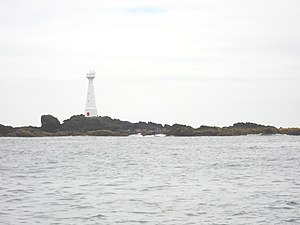Formigas
| Formigas | ||
|---|---|---|
| Formigas with lighthouse | ||
| Waters | Atlantic Ocean | |
| archipelago | Azores | |
| Geographical location | 37 ° 16 ′ N , 24 ° 46 ′ W | |
|
|
||
| Number of islands | 9 | |
| Main island | South Formiga | |
| Total land area | 0.009 km² | |
| Residents | uninhabited | |
| Map of the Formigas from 1849 | ||
The Formigas (Portuguese, in German ' ants ') are a group of small, uninhabited islands in the Atlantic . They belong to the Portuguese Azores and were discovered by Gonçalo Velho Cabral in 1431 . They form the easternmost land mass of the Azores.
The archipelago , which extends north-south over a length of 10 km, is located in the east of the Azores between the islands of São Miguel and Santa Maria, 37 km away . They are managed by the Port Authority of Freguesia Vila do Porto , based in the west of Santa Maria Island.
It consists of nine islets, the highest of which, Formigão (in the essay of 1849 Tofiño Hermigon ), is 10.7 meters high according to official information. Their total area is about 9000 m². The two largest islands are only about 180 m long and 40 m wide. During the last Ice Age , the Formigas were part of an island over 30 square kilometers in size, which has since almost completely disappeared due to the rise in sea levels.
To this day, the Formigas are an area feared by seafarers, as they only rise a few meters above sea level; many have already been shipwrecked here . Since 1948, the islands have been marked by a 19 m high lighthouse on the southernmost 3 m high rock, whose beacon can be seen at night from Santa Maria.
The Formigas are since 1988 by a decree of the Azorean parliament (Decreto Legislativo Regional n.º 11/88 / A, de 4 de Abril) a maritime nature reserve, which is 35.42 km². Many divers visit the surrounding, only a few meters deep shallow water area ( Banco Dollabarat ), whose rich underwater fauna is famous.
Geologically, the Formigas represent a long-extinct volcano , the basaltic base of which is made up of subaerically deposited lava layers and is partially covered by sedimentary rocks. They contain many fossils, which is unusual for the Azores.
Picture gallery
Formigas lighthouse
literature
- Alexander Vidal: The Formigas Bank, near Santa Maria (Azores) . In: Journal of the Royal Geographical Society of London. Volume 19, 1849, pp. 160-166, JSTOR 1798091 .
Web links
Individual evidence
- ↑ Decreto-lei nº 265/72 de 31 de julho
- ^ Lighthouses of Portugal: Azores





